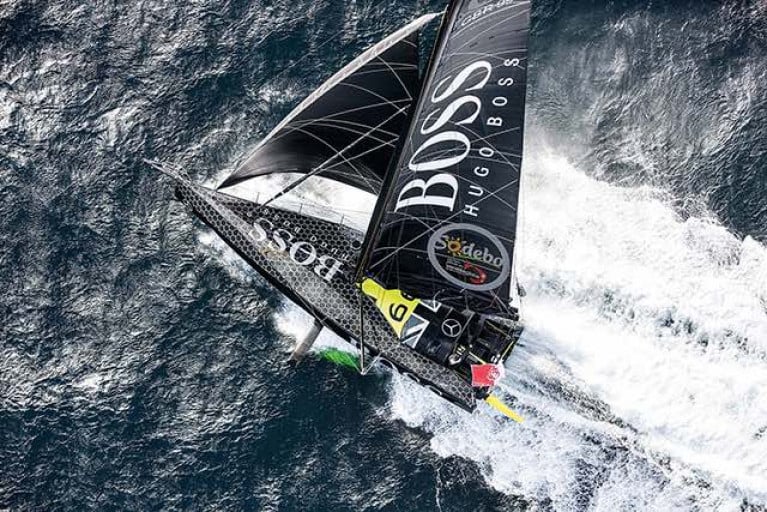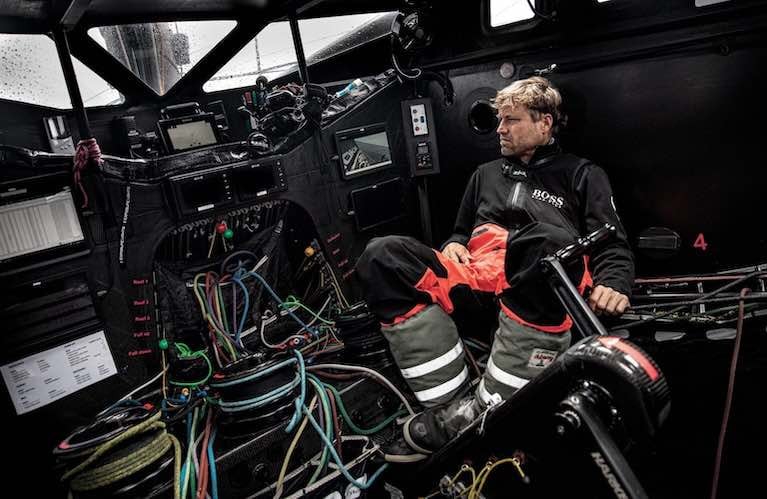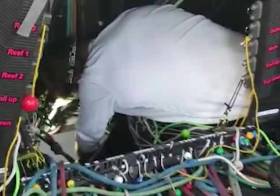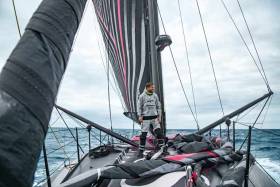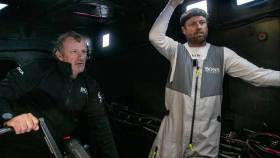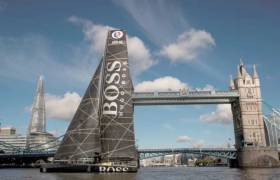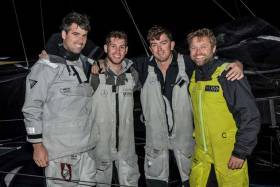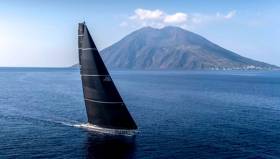Displaying items by tag: Hugo Boss
Huge Support for Alex Thomson as he Heads for Cape Town After Vendee Globe Withdrawal
Charlie Dalin, the Vendée Globe race leader, should pass the longitude of the Cape of Good Hope on Monday, the first of the mythical 24,296 nautical miles solo round the world’s three Great Capes. That his elapsed time since the race started in Les Sables d’Olonne will be around 22 days might be of some tiny consolation to British skipper Alex Thomson who is heading to Cape Town.
His Vendée Globe may be over because of a broken rudder sustained on Friday evening but the blistering pace of 17 days 22hrs 58 seconds that Thomson leading the 2016-17 race remains intact, and is likely to remain so for at least another four years.
The bitterly disappointed 46-year-old from Gosport, Hampshire in England has explained briefly what happened to his rudder, believing that some discarded or lost fishing equipment caused the fracture.
“I was averaging 21 knots, flying the small gennaker and one reef in the mainsail. I was down below when there was a huge bang and the boat broached violently. The steering system was jammed and all I could do was roll the sails away. Once on deck, I could see the rudder blade was broken and swinging around with a large piece of fishing gear jammed into the cracks. So I think I must have hit something. It certainly looks that way. Now I am having to keep the boat flat while I sail the boat now with just one rudder to Cape Town.”
Even after losing four days and nights slowed to make structural repairs, Thomson was sure he had the capacity to win, “I still felt that we could win it, I really did “I’m obviously devastated.”
From the skippers still racing and fans and supporters around the world there has been a huge outpouring of support and good wishes for the popular skipper. French rival Jérémie Beyou, who restarted nine days after the original start due to damage to his own rudder on Charal send a message of solidarity to the sailor who should have been his closest rival on this ninth edition of the race.
Many race followers had expected and hoped for a Thomson v Beyou title match but the dreams of both race heavyweights are over. Beyou crossed the Equator today and is still over 350 nautical miles behind the 31st placed Kojiro Shiraishi and 3,300 miles behind Dalin, having restarted at 2,715 miles behind the then leader HUGO BOSS.
“It is so tough for Alex. I know how hard it is to be in his place. I have been there and even this time was just inches from being in the exact same situation. I know how hard it is to prepare a Vendée Globe and to do it, three, four, five times, to be there to try and always be reaching that holy grail, that first place. I know all the things he has had to do to prepare his boat, all he has been through to get here, and then he has nothing, no comeback, no closure. I feel so bad for him as bad as if it were happening to me. He called me when I had to turn back and he had some very nice words to say. I told him yesterday to hold his head high because there will be time to analyse it all, but all that he has done to prepare this race is something to be proud of.” Said Beyou when he spoke on the Vendée Globe Live show this lunchtime.
He added, “Hearing Damien Seguin talk earlier and seeing the conditions they have in the Southern Ocean makes me really want to be with those friends up ahead; it is not so easy to be this far behind. I am trying to make the boat go as fast as possible and have chosen a course that is direct down the Atlantic and cut off the corner."
Dalin’s lead remains steady at around 300 nautical miles ahead of Thomas Ruyant (LinkedOut) while Jean Le Cam (Yes We Cam!) and Kevin Escoffier (PRB) have been trading third place over the course of Sunday.
Among those who remain impressive as first timers in the south are Yannick Bestaven in fifth on Maître CoQ IV, pushing Escoffier hard. Sébastien Simon on the new Juan K designed ARKEA PAPREC has been quick and making steady inroads now in seventh chasing sixth placed Louis Burton (Bureau Vallée 2) who is just 11 miles ahead. Paralympic medallist Damien Seguin is outstanding in ninth driving his powerful, non-foiling 2008 Finot Conq designed Groupe Apicil very hard indeed, likewise Les Sables d’Olonne rookie Benjamin Dutreux on the Farr designed OMIA-Water Family is in 12th, just six miles behind Sam Davies who is 11th on Initiatives Coeur.
Hugo Boss & Alex Thomson Out of Vendee Globe Race
Alex Thomson, the pre-race favourite to win the Vendee Globe, is out of the non-stop round the world race this afternoon after suffering rudder damage in the Southern Atlantic.
The British sailor is heading for Cape Town after a week of setbacks on his boat Hugo Boss.
The incident occurred on what was Thomson’s 19th day of racing, and it followed significant effort over the last five days and nights repairing cracks to the internal bow structure of his boat. Thomson was getting into his stride at the gateway to the Roaring Forties where his latest generation IMOCA was designed to be at its best.
Alex is currently 1,800 nautical miles from Cape Town and it is expected to take him around seven days to make the journey.
The British skipper, who was racing in the Vendée Globe for the fifth time, had received huge support and respect from around the world for the efforts he made to repair the bow area but there was no way to safely fix the rudder damage to allow him to race on for the what would have been the best part of one month in the hostile Southern Ocean.
Alex Thomson said, “Unfortunately, a repair is not possible. We therefore accept that this will be the end of the race for us. Myself, my team and our partners are of course deeply disappointed. We believe the best was yet to come in this race”
One of the two outstanding favourites to win this Vendée Globe, Thomson was third on the 2012-13 edition and finished second in 2016-17 after fighting back from being 48 hours behind eventual winner Armel Le Cléac’h at Cape Horn to finish only 16 hours behind the French skipper.
Luck has rarely run in his favour on this non-stop solo round the world race. In 2004-5 on his first attempt he had to abandon into Cape Town with damage to his deck after his boom gooseneck failed and in 2008-9 he had to retire early in the race with structural problems caused by a huge gale on the Bay of Biscay.
A statement from Alex and the team:
*******************
After incurring damage to the starboard rudder of the boat, Alex has ceased racing in the Vendée Globe and is now sailing the boat towards Cape Town.
Alex last night disconnected the starboard rudder and has since been sailing the yacht with just one rudder. After assessing the situation today, Alex and the team have decided that the only course of action is to cease racing and sail the boat to Cape Town.
Alex said: “Unfortunately, a repair is not possible. We, therefore, accept that this will be the end of the race for us. Myself, my team and our partners are of course deeply disappointed. We believe the best was yet to come in this race”.
Alex is currently 1,800 nautical miles from Cape Town and it is expected to take him around seven days to make the journey. He’ll do so without the use of his starboard rudder and so will proceed safely and cautiously.
Our technical team will travel to Cape Town to meet the yacht upon arrival.
On behalf of Alex and the team, we thank you for your support during this time.
Vendee Globe Favourite Alex Thomson Issues Alert on 'Possible Structural Issue' for Hugo Boss
One time leader of the Vendee Globe British Skipper Alex Thomson who lost the lead in the race on day 13 yesterday has now notified race officials and his team of 'a possible structural issue' on board.
Thomson, the race favourite, is located approximately 800 miles east of Rio de Janeiro in the South Atlantic ocean and was 13 days into the Vendée Globe round-the-world yacht race.
Thomson is currently only making six knots. His four-hour average is the same so it appears he is doing something to try and assess or make a repair over the last four hours.
Interestingly, new race leader Linked Out is also way down on speed also and has averaged 10 knots for the last four hours, whereas next best Apiva is doing an average of 15 knots when all seem to be in a similar strength wind.
A statement has been released by Thomson's team:
At approximately 19:00 UTC on Saturday 21st November, British Skipper Alex Thomson notified his team onshore of a possible structural issue onboard the HUGO BOSS boat.
At the time, Thomson was located approximately 800 miles east of Rio de Janeiro in the South Atlantic ocean, and was 13 days into the Vendée Globe round-the-world yacht race.
Thomson and his team, together with their appointed naval architects and structural engineers, are now working together to assess the extent of the structural issue and to determine a repair programme and timeline.
Thomson is safe and well onboard, and in regular dialogue with the team. The Vendée Globe race organisation has been notified and is being kept well informed.
We kindly ask that members of the public refrain from attempting to contact the team at this time. A further update will be released on Sunday 22nd November.
Keelless Hugo Boss Headed to Cape Verde Islands
The now keelless IMOCA 60 Hugo Boss that has retired from the Transat Jacques Vabre Offshore Race after striking an underwater object is heading for the Cape Verde Islands.
Ross Daniel, the Technical Director of Alex Thomson Racing said: “Alex and Neal are safe and making good progress onboard Hugo Boss. They are now around 300 miles away from the Cape Verde Islands, sailing with caution at around 10 knots. They have both managed to get some sleep and are focused on getting safely to land.
“Members of the Alex Thomson Racing technical team have arrived in Cape Verde and are preparing for the boat’s arrival. Further members of the team will make the journey in the coming days in order to meet Alex and Neal, and to facilitate the boat’s safe arrival.
“Our current routing has the boat arriving by Friday morning. We are in regular communication with our skippers and are monitoring the boat’s progress around the clock, as we will continue to do until Hugo Boss is safely into port”.
Alex Thomson Cuts Keel off Hugo Boss
Hugo Boss said today (Monday) that after exhausting all the options, they had decided to cut the keel off their 60ft monohull after damage forced them to withdraw from the 14th edition of the Transat Jacque Vabre Normandie Le Havre on Sunday.
“Last night Alex and Neal were both able to get some rest on board Hugo Boss,” Ross Daniel, Technical Director at Alex Thomson Racing, said. “In the early hours of this morning the skippers resumed their attempts to stabilise the keel.
“Despite their very best efforts, it became clear that keeping the keel attached would put the boat at great risk. With the keel attached only by the hydraulic ram, and in an unstable position, there was a serious risk of significant damage to the hull.
"it was far too dangerous to keep the keel in place"
“We did everything that we could to preserve the keel but collectively we determined that it was far too dangerous to keep it in place.
“Therefore, with guidance from our team shore-side, Alex and Neal set about cutting the hydraulic ram to free the keel from the boat. After many hours, they were successful in their efforts and the keel is now no longer attached to the boat.”
Hugo Boss had completed just over a third of the 4,350-mile course of this biennial double-handed race to Salvador de Bahia, Brazil - the longest and toughest in the sailing calendar – when they informed the race office that they collided with an unknown object.
The newly-launched and much admired Hugo Boss is in the middle of the Atlantic Ocean, and now about 460 miles southwest from Madeira and 400 miles northwest of the Canary Islands.
“Alex and Neal have filled the ballast tanks on board and fully extended the foils in order to keep the boat as stable as possible,” Daniel said. “They are currently in light winds and a slight sea state, and we are comfortable that there is no immediate risk to the boat or the skippers.
“The next step is for us to put together the best possible strategy to bring the boat slowly and safely to port. We are currently exploring various options and will provide an update in due course”.
Thomson & McDonald Look for Port of Refuge After Damage to Hugo Boss
Transat Jacques Vabre competitors Alex Thomson and Neal McDonald are working on the safest place to navigate their damaged 60ft monohull, Hugo Boss, after announcing their withdrawal from the 14th edition of the offshore race.
As Afloat reported earlier, the British duo informed the TJV race office that they were withdrawing from the race with the keel of their brand new 60ft monohull attached only by the hydraulic ram after hitting something in the water whilst travelling at around 25 knots at 09:57 UTC.
Hugo Boss had completed just over a third of the 4,350-mile course of this biennial double-handed race to Salvador de Bahia, Brazil - the longest and toughest in the sailing calendar. It will be little comfort to Thomson that his situation would appear to be a lot better than when he was helicoptered to safety after capsizing his previous boat in 2015.
"Hugo Boss had completed just over a third of the 4,350-mile course"
Both skippers were working with their technical team on the best destination. The newly-launched and much admired Hugo Boss is in the middle of the Atlantic Ocean, about 420 miles southwest from Madeira and 380 miles northwest of the Canary Islands.
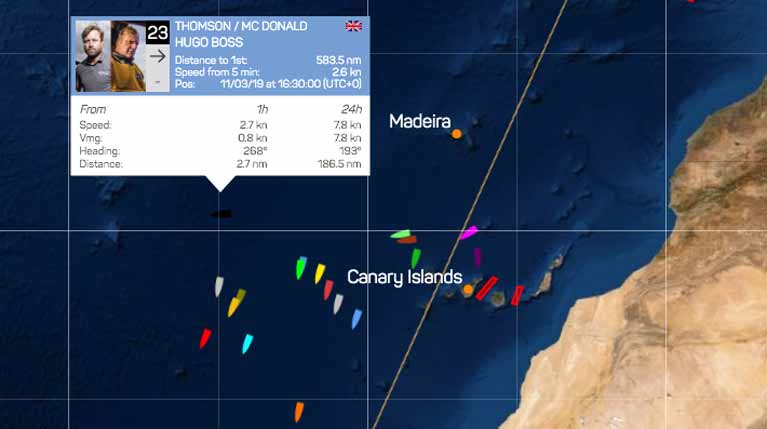 Hugo Boss is about 420 miles southwest from Madeira and 380 miles northwest of the Canary Islands
Hugo Boss is about 420 miles southwest from Madeira and 380 miles northwest of the Canary Islands
Hugo Boss Out of Transat Jaques Vabre With Keel Damage
British skippers Alex Thomson and Neal McDonald (Hugo Boss) are out of the Transat Jacques Vabre Race after hitting an object at sea this morning just a week into the offshore race.
The much-fancied British entry that has strong ties to Cork Harbour was 18th of the Imoca race to 484.84 nautical miles leaders Jérémie Beyou and Christopher Pratt (Charal).
Following the incident, Alex and Neal stopped the boat and carried out an inspection to assess the damage sustained. It became apparent that the keel is now only attached by the hydraulic ram.
The new yacht was launched in August as Afloat reported here.
Due to the damage sustained to the boat, the decision has been made that Alex and Neal will not continue on in the race.
The Alex Thomson Racing team is now working to assist the skippers to bring the boat to the nearest port.
Both Alex and Neal are currently safe inside the boat and did not sustain any major injuries.
Thomson Sets New Monohull Speed Record On Hugo Boss
British offshore skipper Alex Thomson and his crew sailing the IMOCA 60 Hugo Boss have officially broken the 24-hour distance record for a 60ft monohull, as Sail-World reports.
Thomson — who sailed with fellow 2020 Vendée Globe challenger Nin O’Leary on Hugo Boss last year — raced 539.71 nautical miles over the course of 24 hours, breaking his own extant record set last year by 2.9nm.
The new record was ratified last week after the feat achieved on 19-20 July during a transatlantic crossing from New York to the UK. Sail-World has more on the story HERE.
Royal Cork's Nin O’Leary Shares Hugo Boss’s Success in Middle Sea Race
George David’s Rambler 88 has taken line honours for the owner’s third time in the 608-mile Rolex Middle Sea Race currently finishing in Valetta writes W M Nixon. But Nin O’Leary and Alex Thomson in the IMOCA 60 Hugo Boss have turned in a virtuoso offshore performance to be third home across the line, bested only by the significantly larger Rambler and the 100ft Leopard.
Unlike the Fastnet Race 2017, where Hugo Boss suffered from having to beat the whole way from Cowes to the Fastnet Rock, thereby leaving inadequate space and distance to demonstrate her formidable offwind capacity, in this race the “lovely black boat” was able to lay the course – albeit in often very light winds – most of the way on the anti-clockwise circuit towards the most northerly turning point, the volcanic island of Stromboli.
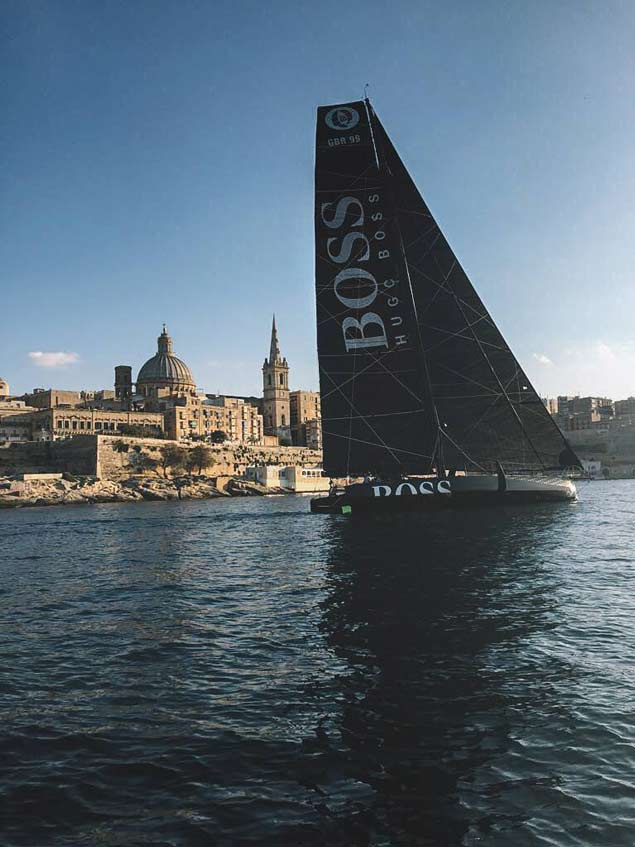 Hugo Boss gets smoothly away from Valetta at the start. Although winds were light all the way to the northerly turn at Stromboli, they were seldom dead on the nose and the specialised IMOC 60 was able to stay well placed. Photo: Kurt Arrigo
Hugo Boss gets smoothly away from Valetta at the start. Although winds were light all the way to the northerly turn at Stromboli, they were seldom dead on the nose and the specialised IMOC 60 was able to stay well placed. Photo: Kurt Arrigo
There, with a west to nor’westerly filling in to eventually become a classic Mistral-generated Mediterranean gale, most of the fleet elected for long tack/short tack progress towards Sicliy’s decidedly rugged northwestly coast’s series of massive headlands. But Hugo Boss’s crew chose to continue to lay on port tack far offshore, accepting the reality that right-on windward work is not their boat’s strong suit.
Thus they found both a slightly more favourable slant of wind well offshore, and a more regular sea state. The northwest corner of Sciliy is notorious for its confused back-wash ridden sea, and when Hugo Boss closed with the fleet again yesterday morning, they were already approaching Sicily’s most westerly race turn at Favignana island, finding themselves in company with the larger boats, and now well ahead of 50ft to 65ft craft which had been hassling them earlier in the race.
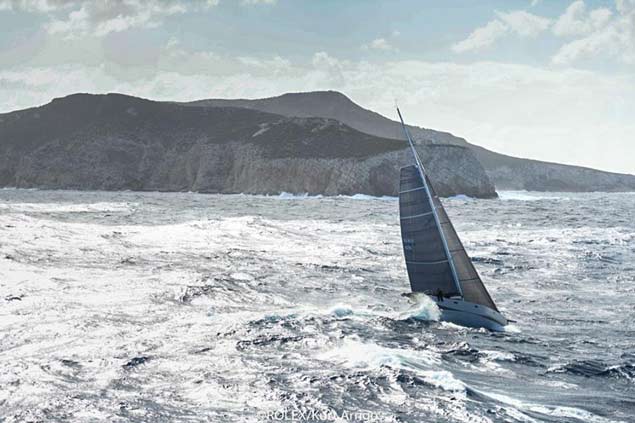 The Botin 65 Caro (Maximilian Klink, Germany) kicks her heels in heavy winds in the backwash-plagued rough seas off Sicily’s northwest coast. Boats that gave much of this coast a good offing, such as XP-ACT and particularly Hugo Boss, benefitted from more regular seas Photo: Kurt Arrigo
The Botin 65 Caro (Maximilian Klink, Germany) kicks her heels in heavy winds in the backwash-plagued rough seas off Sicily’s northwest coast. Boats that gave much of this coast a good offing, such as XP-ACT and particularly Hugo Boss, benefitted from more regular seas Photo: Kurt Arrigo
With Favignana astern, it was all systems go, and at the front of the fleet while Rambler 88 – which was to cover the final 300 miles in 14 hours – was unassailable, for a while Hugo Boss looked as though she might be able to pip Leopard for second place on the water.
It was not to be, as things were easing slightly as the leaders came into Valetta late last night and in the small hours of this morning. With the pace dropping. Rambler 88 was able both to finish first and beat Hugo Boss on corrected time, albeit by just 5 minutes and 26 seconds. But O’Leary and Thompson and their crew of Will Jackson and Jack Trigger (there’s only room for two extra on the very purpose-designed IMOCA 60) were able to beat Leopard (Pascal Oddo, France) by 55 minutes on CT, while Udde Ingvall’s super-skinny Maxi 98 CQS from Australia has finished fourth across the line, almost ten hours astern of Hugo Boss on corrected time.
The severe conditions north of Sicily have taken their toll of the fleet and Irish entries, with Two-Handed favourites Brian Flahive of Wicklow and Sean Arrigo of Malta with the J/122 Otra Vez an early retiral, while Conor Doyle of Kinsale with the DK 46 Hydra had managed to get as far as the great headlands of northwest Sicily before pulling out.
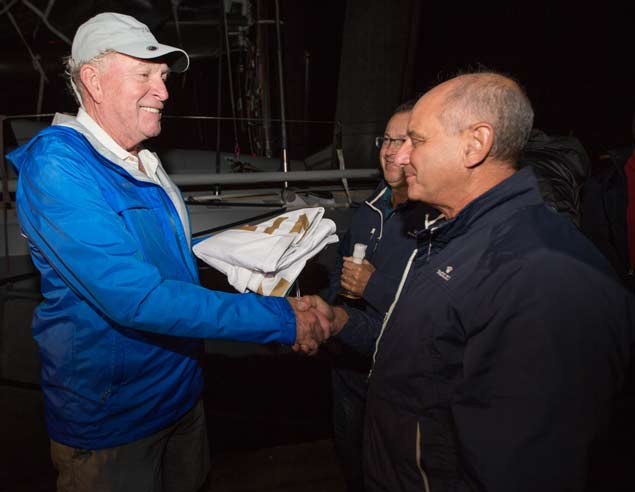 He’s done it again. George David (left) receives the line honours flag for the third time from Royal Malta YC Commodore Godwin Zammit
He’s done it again. George David (left) receives the line honours flag for the third time from Royal Malta YC Commodore Godwin Zammit
But Ireland’s most experienced participant, Middle Sea Race 14-times veteran2012 Barry Hurley, is sailing a really cool race with Shane Giviney and other noted talents on the Xp44 XP-ACT. Having given those bouncy northwestern headlands a decent offing to get them quickly clear while maintaining a good fleet place, they’ve just passed Pantellaria and are lying fourth overall on corrected time.
Current handicap leader is the 2012 Swan 53 Music (James Blackmore, South Africa) while the Russian JPK 10.80 Bogatyr (Igor Rytov) is second and the former Round Ireland star Tonnere de Breskens, the Ker 46 now known as Tonnere de Glen and owned by Tian Domonique of France, is third, with XP-ACT in fourth overall and well clear of the next boat.
Speeds are still well up, but with the wind easing it’s going to be a long day getting past Lampedusa and across to the finish at Valetta.
Race tracker here
Middle Sea Race: Hugo Boss Makes Superb Work of Tricky Conditions, Rambler Recovers From Being Stuck at Stromboli
Everyone going into the 608-mile Rolex Middle Sea Race knows they will experience a challenging course with weather which can be anything and everything from extended calms to surprisingly vicious gales, and the 2017 edition is no exception writes W M Nixon
In mostly light easterly winds after the start on Saturday, the fleet’s stately progress saw George David’s Rambler 88 give a master-class in taking full advantage of every new if small improvement in wind strength, and she lengthened away from the likes of the 100ft Leopard and the 98ft CQS in impressive style, only to see it evaporate again as she was invariably the first one into the next belt of calm.
However, she was always in the lead, and was on the up and up approaching Stromboli yesterday, only to find things very flat beyond that splendid turning point. Increasing desperate to find breeze anywhere, and always looking to be first into the much-forecast strong to gale west to norwest wind which was expected last night, she crawled along at barely a knot and ended out somewhere about nor’nor’east of Stromboli, taking a very wide turn before she began to feel the first of a new air. This eventually became the breeze which gave her a long tack/short tack beat to the next turn at the island of Favignana west of Sicily’s most westerly headland.
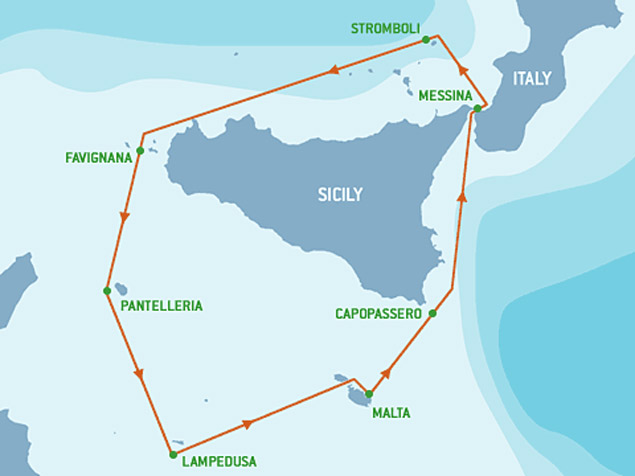 The 608-mile Rolex Middle Sea Race has a bit of everything – and sometimes a lot of wind. Rambler is now on the Pantelleria-Lampedusa stage, tearing along at up to 26 knots in a mighty west to northwest wind.
The 608-mile Rolex Middle Sea Race has a bit of everything – and sometimes a lot of wind. Rambler is now on the Pantelleria-Lampedusa stage, tearing along at up to 26 knots in a mighty west to northwest wind.
It was the IMOCA 60 Hugo Boss (Alex Thompson & Nin O’Leary) which went most determinedly to the northwest. They’d actually arrived at Stromboli at a time when a neat rounding had become possible, but knowing their very special boat’s notable lack of enthusiasm for tacking duels and windward work generally, they slugged on for many miles on port tack until they could hope to lay Favignana without having to tack again.
It was a tactic which worked a treat, and now while the bulk of the fleet are still bashing it out in rugged weather north of Sicily, Hugo Boss is screaming along at 24 knots and more from Favignana towards the next turn at Pantellaria, third on the water to Leopard which is slower at 22 knots, while Rambler is already past Pantellaria and making 26 knots for Lampedusa, the final turn before the finish at Valetta.
The speeds being achieved by the three leaders could well invert the leaderboard’s former emphasis in smaller craft, which still have an awful lot of hard sailing to Favignana before they can let rip. Otra Vez (Brian Flahive & Sean Arrigo) had been well placed in the two-handed division, but now seems to signal retirement, however Xp-ACT with Barry Hurley and Shane Diviney in her crew is well-placed for the Favignana rounding, while Conor Doyle’s chartered Hydra has also made good progress along Sicily’s north coast.
But having seen small boats dominate the top placings early on, we now have the fascinating prospect of the three leading biggies carrying the strong favourable winds all the way to the finish at enormous speeds, and turning the results upside down.
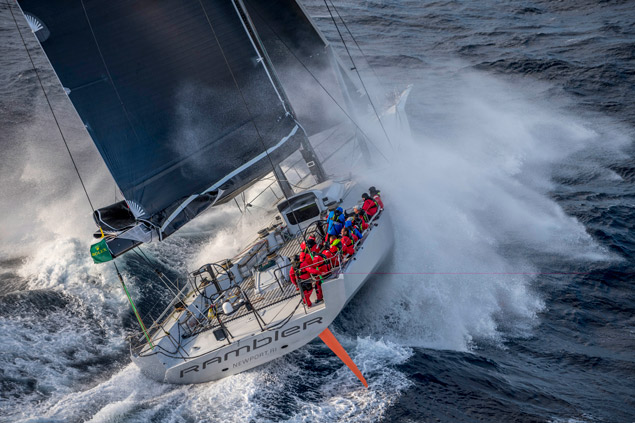 Here we go……Rambler starts to free off as she weathers Favignana at eight o’clock this morning. Photo: Kurt Arrigo
Here we go……Rambler starts to free off as she weathers Favignana at eight o’clock this morning. Photo: Kurt Arrigo
Tracker here


























